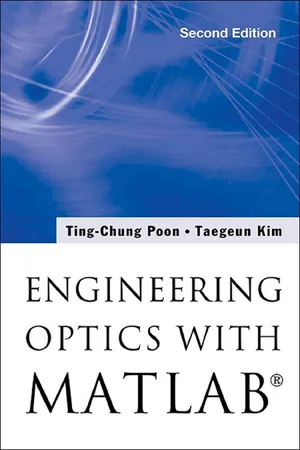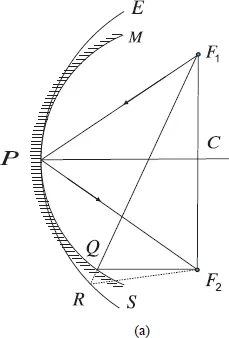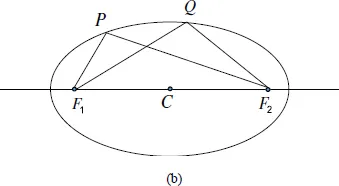![]()
Chapter 1
Geometrical Optics
When we consider optics, the first thing that comes to our minds is probably light. Light has a dual nature: light is particles (called photons) and light is waves. When a particle moves, it processes momentum, p. And when a wave propagates, it oscillates with a wavelength, λ. Indeed, the momentum and the wavelength is given by the de Broglie relation
where h ≈ 6.2 × 10−34 Joule-second is Planck’s constant. Hence from the relation, we can state that every particle is a wave as well.
Each particle or photon is specified precisely by the frequency v and has an energy E given by
If the particle is traveling in free space or in vacuum, the frequency is ν = c/λ, where c is a constant approximately given by 3 × 108m/s. The speed of light in a transparent linear, homogeneous and isotropic material, which we term u, is again a constant but less than c. This constant is a physical characteristic or signature of the material. The ratio c/u is called the refractive index, n, of the material.
In geometrical optics, we treat light as particles and the trajectory of these particles follows along paths that we call rays. We can describe an optical system consisting of elements such as mirrors and lenses by tracing the rays through the system.
Geometrical optics is a special case of wave or physical optics, which will be mainly our focus through the rest of this chapter. Indeed, by taking the limit in which the wavelength of light approaches zero in wave optics, we recover geometrical optics. In this limit, diffraction and the wave nature of light is absent.
1.1Fermat’s Principle
Geometrical optics starts from Fermat’s Principle. In fact, Fermat’s Principle is a concise statement that contains all the physical laws, such as the law of reflection and the law of refraction, in geometrical optics. Fermat’s principle states that the path of a light ray follows is an extremum in comparison with the nearby paths. The extremum may be a minimum, a maximum, or stationary with respect to variations in the ray path. However, it is usually a minimum. In Figs. 1.1a and b, we show the situations for a maximum and being stationary, respectively (the situation for a minimum will be discussed when we talk about the laws of reflection and refraction in the next section).
Fig. 1.1. (a) Spherical mirror.
Fig. 1.1. (b) Elliptical mirror.
In Fig. 1.1a, we inspect reflection from a spherical mirror (M). Point C represents the center of curvature of the spherical mirror and the distance CP is the radius of curvature of the mirror. We also construct an ellipse (E) passing through P with foci F1 and F2. Now consider light starting from F1 and reaching F2 upon reflection from P. The ray’s path length is F1P + PF2. Now consider another path length F1Q + F2Q, where Q is another point on the spherical mirror. Since QR + RF2 > QF2, where R is the point on the ellipse when we extend line F1Q to intercept the ellipse, F1Q + QR + RF2 > F1Q + QF2. So F1R + RF2 > F1Q + QF2. Now from the property of an ellipse, we know F1P + PF2 = F1R + RF2. Hence F1P + PF2 > F1Q + QF2, i.e., the ray of an actual ray path is always longer than a neighboring path and this case represents that the extremum is a maximum. Figure 1.1b shows an elliptical mirror on the top half of the ellipse with foci F1 and F2. We can see that any ray starting from one of the foci, say F1, after being reflected from any point (P or Q) on the mirror will pass through the other focus, F2. From the property of an ellipse, F1P + PF2 = F1Q + QF2. Hence all rays after reflection have the same path length and this is the case that that the extremum...




